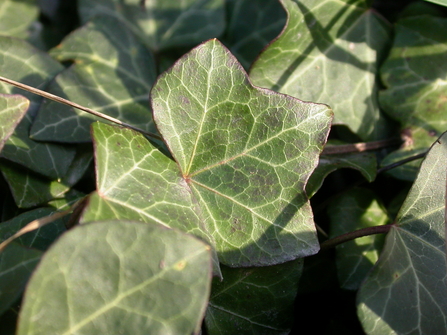
Ivy by Phillip Precey
Common ivy is native to Britain and widely distributed across Suffolk. It is an adaptable woody climber, able to grow in most soil types and is resilient to changes in climatic conditions. The foliage, flowers and berries of ivy provide an excellent habitat for wildlife.
Whether trailing over a village wall, forming part of a hedgerow or growing up a tree trunk in a churchyard, the foliage, flowers and berries of ivy provide an excellent habitat for wildlife throughout the year for many species of birds, insects and even small mammals and should be managed carefully.
The wildlife value of ivy
During the spring, ivy provides good cover for nesting birds. Its berries, which appear from November, will stay on a bush until April if not eaten immediately. This fruit gives birds a good source of food through the winter and early spring and is a particular favourite of blackbirds, but it is also commonly eaten by song thrushes, mistle thrushes, redwings, wood pigeons, collared doves, robins and blackcaps.
The presence of ivy will often encourage an early show of spring butterflies, as it flowers between September and November and therefore provides a good early source of nectar. It is also provides a valuable overnight refuge for butterflies at other times of the year.
In late autumn, butterflies such as the holly blue and red admiral, as well as many moth species, are attracted to the ivy flowers. As it provides food for many pollinating insects, wasps, green bottles and honeybees are frequent visitors to ivy flowers during September and October.
The succession of flowers in November and December are also important to the survival of queen wasps. The often dense foliage provides an excellent food source or rest site for small mammals, particularly through the barren winter months. As an evergreen plant it is particularly valuable through the winter, when it is used by hibernating butterfly species such as small tortoiseshell, peacock, painted lady, comma and brimstone.
Ivy does not damage trees
It is commonly thought that ivy growing on a tree trunk is damaging to the tree, but in fact this can often be an indicator of a well established tree. This may often be found in churchyards, which in themselves are of great value to wildlife. Many trees can survive with large amounts of ivy on them, which can actually help to protect the trunk by dissipating potentially damaging wind energy. However, regular trimming will effectively control ivy where necessary.
Growth forms
Ivy is unusual in that it has two growth forms – juvenile and adult. It may stay in a juvenile form indefinitely, during which time no flowers or fruit are produced. This form of the plant is climbing or creeping, with many aerial shoots and suckers. As the ivy matures it takes its adult, or arborescent form. It has no aerial roots, and has generally unlobed or slightly lobed leaves arranged spirally around the stem. Flowers and then fruits are produced only if and when the plant reaches this adult form.
Whilst ivy can retain its juvenile form for some years due to the environmental conditions in which it is growing, you can encourage ivy to develop into the arborescent plant and produce flowering stems by pulling the top shoots away from their support so that they hang free. This arborescent form has a wider benefit to wildlife.
Management of ivy
• The precise management of ivy should be appropriate to its location and position within its habitat, but generally the plant’s growth can be controlled by annual trimming back between September and January. Wherever the ivy is growing, care should be taken to avoid the bird nesting season between March and July
• Cutting back in the autumn or winter will result in the loss of some of the berries. It is therefore a good idea where possible not to trim all the ivy in an area at the same time but to alternate or rotate the areas cut back each year so that the valuable fruit will not all be removed at the same time
• If ivy forms part of a hedgerow, it should be cut in winter with the rest of the hedge, ideally in early February
• Whenever possible ivy should be left on walls to provide nesting sites and a late nectar source for insects
• Whilst severe cutting back is not necessary, ivy may need to be restrained when growing on buildings, particularly on loose brickwork
